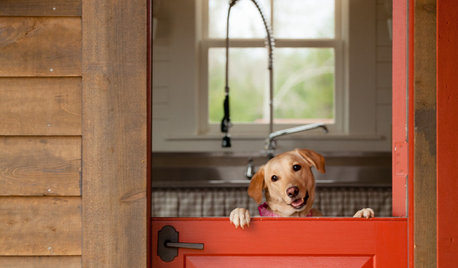Help with new lawn (dog related)
KBKB14
9 years ago
Related Stories

LIFEThe Polite House: On Dogs at House Parties and Working With Relatives
Emily Post’s great-great-granddaughter gives advice on having dogs at parties and handling a family member’s offer to help with projects
Full Story
PETS6 Ways to Help Your Dog and Landscape Play Nicely Together
Keep your prized plantings intact and your dog happy too, with this wisdom from an expert gardener and dog guardian
Full Story
PETSHow to Help Your Dog Be a Good Neighbor
Good fences certainly help, but be sure to introduce your pup to the neighbors and check in from time to time
Full Story
EARTH DAYThe Case for Losing the Traditional Lawn
Work less, help the environment and foster connections by just saying no to typical turf
Full Story
GARDENING GUIDES8 Unthirsty Plants Help You Save Water in Style
Spend less effort and money on your landscape with drought-tolerant and native plants that liven up your yard
Full Story
ORGANIZINGDo It for the Kids! A Few Routines Help a Home Run More Smoothly
Not a Naturally Organized person? These tips can help you tackle the onslaught of papers, meals, laundry — and even help you find your keys
Full Story
MOST POPULAR9 Real Ways You Can Help After a House Fire
Suggestions from someone who lost her home to fire — and experienced the staggering generosity of community
Full Story
STANDARD MEASUREMENTSThe Right Dimensions for Your Porch
Depth, width, proportion and detailing all contribute to the comfort and functionality of this transitional space
Full Story
SELLING YOUR HOUSE10 Low-Cost Tweaks to Help Your Home Sell
Put these inexpensive but invaluable fixes on your to-do list before you put your home on the market
Full Story
MOVINGRelocating Help: 8 Tips for a Happier Long-Distance Move
Trash bags, houseplants and a good cry all have their role when it comes to this major life change
Full Story






morpheuspa (6B/7A, E. PA)
KBKB14Original Author
Related Professionals
Reading Landscape Architects & Landscape Designers · Windham Landscape Architects & Landscape Designers · Cary Landscape Architects & Landscape Designers · Finneytown Landscape Architects & Landscape Designers · Blue Springs Landscape Contractors · Brownsville Landscape Contractors · Chesapeake Ranch Estates Landscape Contractors · Firestone Landscape Contractors · Florham Park Landscape Contractors · Norristown Landscape Contractors · San Bruno Landscape Contractors · Shoreview Landscape Contractors · Four Corners Landscape Contractors · Goldenrod Landscape Contractors · Pflugerville Swimming Pool Buildersmorpheuspa (6B/7A, E. PA)
KBKB14Original Author
morpheuspa (6B/7A, E. PA)
dchall_san_antonio
morpheuspa (6B/7A, E. PA)